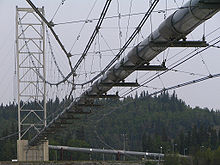A pipeline bridge is a bridge for running a pipeline over a river or another obstacle. Pipeline bridges for liquids and gases are, as a rule, only built when it is not possible to run the pipeline on a conventional bridge or under the river.[1][non-primary source needed] However, as it is more common to run pipelines for centralized heating systems overhead, for this application even small pipeline bridges are common.

Pipeline bridges may be made of steel, fiber reinforced polymer, reinforced concrete or similar materials.[2] They may vary in size and style depending on the size of the pipeline being run. As there is normally a steady flow in pipelines, they can be designed as suspension bridges. They may also be added to an existing bridge.[1] A pipeline bridge may be equipped with a walkway for maintenance purposes,[2] but for safety and security reasons, the walkway is usually not open to the public.[citation needed]
One of the world's longest pipeline bridges, built in 1970, is 1,040 meters long and crosses the Fuji River in Shizuoka Prefecture of Japan.[3] The highest at 393 m is Hegigio Gorge Pipeline Bridge in Papua New Guinea.
References
edit- ^ a b Designation of Energy Corridors on Federal Land in 11 Western States. United States Department of Energy. 21 February 2012. pp. 3-282–3-283. Retrieved 28 March 2023.
- ^ a b Kopáčik, Alojz; Marendić, Ante; Erdélyi, Ján; Kyrinovič, Peter; Paar, Rinaldo, eds. (19 October 2020). Contributions to International Conferences on Engineering Surveying: 8th INGEO International Conference on Engineering Surveying and 4th SIG Symposium on Engineering Geodesy. Springer International Publishing. p. 18. ISBN 9783030519537. Retrieved 28 March 2023.
- ^ Welding and Metal Fabrication. Louis Cassier Company. 1975. Retrieved 28 March 2023.